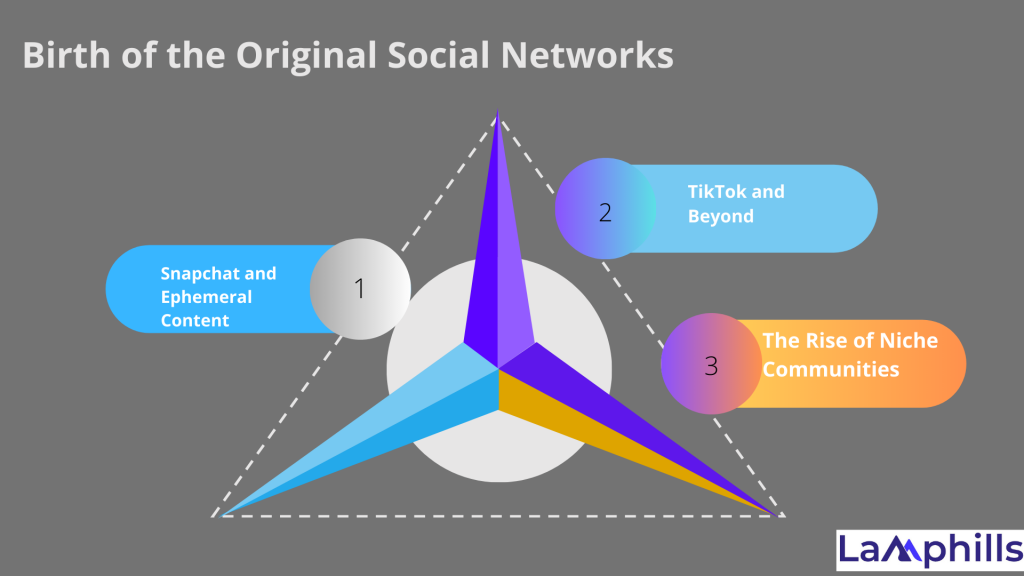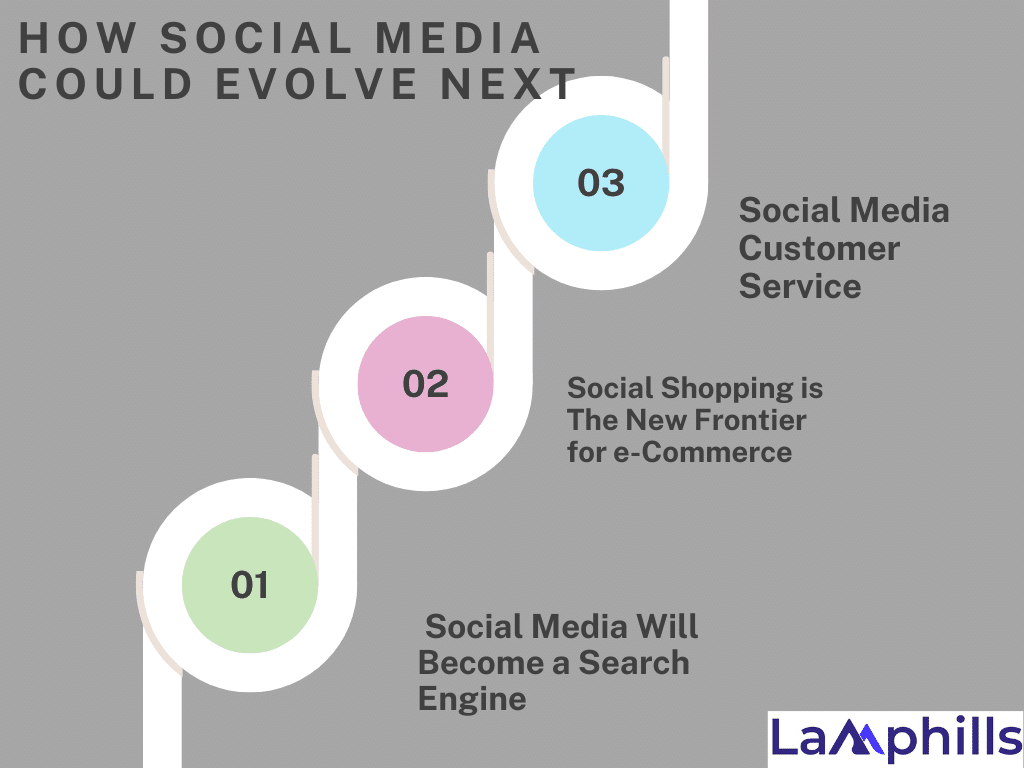Humans have been looking for new ways to communicate since the beginning of time. The communication methods include grunting, cave paintings, speech, letter writing, sign language, and email. Then along came the evolution of social media.
In a relatively short time, social media has transformed how people communicate with one another. According to Pew Research Center data, only 5% of Americans used a major social platform in 2005; by 2022, this figure will have risen to 72%. Statistics estimate that 4.89 billion people worldwide will use social media in 2024.
To be honest, doesn’t it feel like social media has been around forever? However, in the grand scheme of things, its rise has been swift and innovative. I’ve seen firsthand how social media has altered and even reshaped. Now, let me walk you down memory lane, exploring how social media has evolved and what it means for businesses today.
Key Takeaways
- Companies that adapt quickly to social media changes, such as embracing video content, new platforms, or AI, are the ones thriving in today’s digital landscape. Those slow to adapt risk falling behind.
- Platforms like Twitter revolutionized real-time interaction, while newer platforms like Discord and Clubhouse have created spaces for smaller, more intimate communities that foster deeper engagement.
- Instagram, Snapchat, and TikTok emphasize visual storytelling, prompting businesses to rethink their marketing strategies by focusing on aesthetics and creating visually compelling content.
- Emerging trends like AI-driven personalization, augmented reality (AR) shopping experiences, and the growing influence of social commerce are shaping the future of social media marketing. Brands need to adapt to these innovations to remain competitive.
What is Social Media?

There are numerous types of digital communication, but not all are termed social media. Social media refers to websites or programs that allow users to share material, engage, and send messages in a collaborative environment. Now, the focus here is on shareable content and social interaction. While many platforms allow users to publish content, social media promotes increased user interaction and collaboration.
However, the backdrop for these interactions can be wide or niche, depending on the platform’s aim. Some networks, such as LinkedIn, may be more focused on making business contacts and furthering professional development. Others, like as Instagram, may prioritize image sharing over text or target a specific audience.
The Impact of Social Media Evolution on Business Strategy
Adapting to the ever-changing social media setting is essential for businesses. I have had clients who were sluggish to adjust and battled to remain relevant. On the other hand, the companies that embraced change—whether it was transitioning to video content, adopting new platforms, or experimenting with AI—are thriving.
The prospects for digital marketing and audience engagement have never been better. However, these opportunities also bring challenges. Hence, staying ahead requires flexibility, creativity, and an eagerness to learn. If there is one thing I’ve learned from my years of working in this field, it’s that evolution never stops. What works today can be out of date tomorrow.
These tools helped people and businesses stay in contact from the convenience of their living rooms — a foreshadowing of the convenience of smartphone communication.
The Early Days: Evolution of Social Media

Back in the late 1990s, most individuals had no idea what social media was. Six Degrees, the first well-known social networking site, debuted in 1997. While I wasn’t very familiar with digital marketing at the time, I was impressed by how Six Degrees allowed consumers to establish profiles and interact with friends. It seemed like putting your social life online, which was both exciting and strange.
LiveJournal, a less typical social media site, set the path for social media’s self-documenting aspect. LiveJournal, which debuted in 1999, allows users to establish a personal blog, journal, or diary and share their thoughts with friends and the community. Users can also list other members as “friends,” but this has limited functionality and doesn’t need to be reciprocated, as on Facebook. It is more like following someone on Instagram or Twitter. Posts have a comment section, which encourages engagement between community members. The platform is still functioning today.
Then came Friendster, one of the sites most directly related to today’s social networking platforms. This service lets users share photos and videos, as well as more standard text postings and link posts that direct them to other destinations on the internet. It also served as a forum for discovering new material and events. Users might search for one another and communicate directly or through broader networks.
And MySpace in the early 2000s. Ah, MySpace! I’m sure some of you recall creating your profile with HTML (I spent hours on mine), selecting your top 8 buddies, and adding background music. For businesses, this was new terrain. Friendster was so successful that it had 3 million members within its first few months. Having failed to compete with the social media giants that came after it, Friendster was rebranded and relaunched as a social gaming platform in 2011. It eventually shut down in 2018.
Though these early platforms were primarily about personal connection, businesses quickly realized their potential. At this stage, it was mostly small, local companies experimenting. These platforms laid the groundwork for a fundamental shift in how brands interact with consumers.
Evolution of Social Media: Birth Of The Original Social Networks

Although many social networking sites have closed and gone into obscurity, numerous social media apps are still available to modern consumers. Some of these networks have been able to maintain a strong hold over older demographics while gaining new users, proving that they are no longer just for young people.
Following the first wave of “social networks,” came the platforms we know today, or at least the early phases and versions of those we use. Friendster, established in 2002, was one of the earliest. It allows users to connect with their friends, share photos, and find new material. A steady stream of platforms ensued.
#1. Facebook
Facebook was a major changer because it was more than just connecting with friends; it was about building a digital persona, sharing updates, and, most importantly, advertising. When Facebook Ads debuted in 2007, businesses now got the ability to directly target particular groups. I recall starting my first Facebook ad campaign for a client in the fitness industry—it was innovative. We suddenly had tools to reach out to the exact folks we sought. Facebook first became accessible to the general public in 2006. By this time, I had moved into a more strategic marketing role, and I recall clients asking, “Do I need to be on Facebook?” At the time, social media felt like an add-on rather than a necessary component of a marketing strategy. But everything changed rapidly.
#2. Twitter
Around the same time, Twitter was gaining traction. Launched in 2006, Twitter brought a new dynamic: real-time interaction. It was like attending a massive online conference where you could eavesdrop on conversations or jump into debates. The hashtag culture changed the game, especially during live events or product launches. I’ll never forget running a Twitter campaign for a tech company’s product launch, watching hashtag trend, and engaging with customers in real time. It was exhilarating and exhausting, but the immediate feedback was invaluable.
#3. YouTube and the Power of Visual Content
And then, there was YouTube. By 2007, video content was becoming king. I worked with several brands to create video campaigns that had more impact than any blog post could. YouTube didn’t just change social media—it transformed the internet, making video an essential part of every digital strategy.
#4. LinkedIn
LinkedIn, the sole professional-focused community on this list, was the first corporate networking site and has maintained its social position for the past two decades. Both users must agree to be the initial connections, although anyone can “follow” another member and view their public posts. In-platform chat capabilities, discussion sections, and an interactive job board assist professionals in expanding their networks and following the careers of those they know. LinkedIn has been owned by Microsoft since 2015 and has been a popular platform for people to promote their work histories and achievements.
#5. Reddit
Reddit is well-known for its classic look and basic, text-heavy design. This website invites users to upvote and downvote other people’s posts, as well as comment on them. These votes determine how visible a post is on the platform. Redditors can also create “subreddits” inside the community to share messages, photographs, videos, and links with a mix of administrators and member-moderated groups.
Reddit has a stronger sense of community governance than other social media networks, making it popular among specialized groups looking for a safe place to gather online. However, Reddit has recently faced criticism for charging for access to its API.
The Rise of Visual and Mobile-First Platforms

Fast forward to 2012, and social media took a visually stunning turn with the rise of Instagram. This was the era of visual storytelling. Businesses had to start thinking about how their products or services looked rather than just how they sounded. I remember working with a luxury home décor brand. We shifted our entire strategy to focus on Instagram visuals, making sure that every post looked like something out of a high-end magazine. It paid off—Instagram became a lead generator in ways we hadn’t anticipated.
#1. Snapchat and Ephemeral Content
Around the same time, Snapchat introduced the concept of ephemeral content, which were uploads that disappeared after 24 hours. Businesses found this initially puzzling. Why would we want our content to disappear? However, as I experienced while working for a cosmetics company, this produced a sense of urgency and exclusivity. We launched a 24-hour product preview on Snapchat, and the response was incredible. People swarmed to the store the next day, eager to purchase something they had only seen briefly.
#2. TikTok and Beyond
Then came TikTok in 2018. If you’d asked me five years ago whether short, quirky videos would become the backbone of a social media platform, I probably would’ve laughed. But TikTok has taken the world by storm. I’ve helped brands tap into this fast-paced, youth-dominated platform, and the results can be mind-blowing. One campaign I worked on for a lifestyle brand went viral, racking up millions of views in just days. The key was authenticity—TikTok users sniff out ads a mile away, so content has to feel natural and genuine.
#3. The Rise of Niche Communities
Platforms like Discord and Clubhouse have also emerged, giving users spaces to form smaller, more intimate communities. I recently worked with a brand that launched a private Discord server for its most loyal customers. It created a VIP vibe, fostering deeper connections and more meaningful engagement.
How Social Media Has Evolved Even More

What comes next for social media? The future is already taking shape, with trends such as AI-powered content personalization and the rise of AR/VR experiences. I’m particularly enthused about the possibilities for augmented reality. Imagine buying a couch and being able to “place” it in your living room with your phone—this technology is coming and will transform e-commerce.
Aside from the timeline above, other significant moments in social media history include applications adding similar features to competitors, such as Facebook adding photos, Instagram launching “Stories” (a Snapchat-like feature), and Twitter Spaces allowing users to have voice-chat rooms similar to Clubhouse.
We also can’t neglect the rise of social media as a marketing platform, providing firms with new and unique ways to build brand awareness, interact with audiences, and inspire sales. Let’s go over some ways that social media could evolve next.
#1. Social Media Will Become a Search Engine
31% of consumers use social media to find solutions to their questions, with one-fourth of those aged 18 to 54 preferring to search on social media.
Google has noticed this shift, with one of its executives even claiming that Google Search and Maps have lost searches among younger generations, who prefer to use applications like TikTok and Instagram to find places to eat.
Takeaways for Marketers: As social search becomes more popular, brands must adapt by making it simpler for consumers to find them on social media by using relevant hashtags on posts and content, as well as creating recognized and searchable profiles and usernames.
#2. Social Shopping is The New Frontier for e-commerce
One of the most significant new waves of social media is the emergence of social shopping. Consumers of all generations use social networking apps to research products and make purchases, with Millennials and Generation Z leading the way. Social media marketers estimate that in 2023, customers will buy things on social media more frequently than on brand websites, while social sellers report that their businesses are making more sales on social media this year than last.
#3. Social Media Customer Service
With the rise of shopping on social media, consumers look to those same platforms for customer service when buying products. Nowadays, 76% of social media marketers say their business offers customer service on social media, and as time goes on, it will likely be more important for brands to offer.
Takeaways for Marketers: When it comes to offering service on social media, businesses already doing so either have a dedicated customer service rep to handle it, or leave it to the marketer in charge of the platform.
How does social media affect society?
Social media has many uses, including sharing personal updates with friends, brand marketing, and publicizing professional work. Some pros include the following:
- Users can connect instantly with an audience, fostering relationships and building valuable communities.
- Brands can grow an audience and compete with larger rivals.
- Jobseekers can find new career opportunities.
- Local communities can organize around politics or social issues.
- Users can seek out like-minded people as well as connect with family and friends.
What are the four evolutions of media?
Media can be classified broadly into four historical ages: the ages of newspapers and place, magazines, and class, broadcasting and mass, and Internet and space.
Who invented the media?
Johannes Gutenberg’s invention of the printing press enabled the mass production of media, which was then industrialized by Friedrich Koenig in the early 1800s.
What is the root word for media?
The Latin root word medi means “middle.” This Latin root is the word origin of a large number of English vocabulary words, including medieval, mediocre, and media.
Conclusion
The evolution of social media has been chaotic, with unexpected twists and turns that none of us could have imagined. From the early days of MySpace to the fast-paced world of TikTok, social media has altered how we interact, promote, and develop relationships—both personally and professionally.
Now, the key for firms is to maintain their agility. Accept change, experiment with new trends, and always keep your target audience in mind when developing your plan. This is because social media is about people, not just platforms, and knowing their needs, desires, and behaviors will always be the cornerstone of success.






